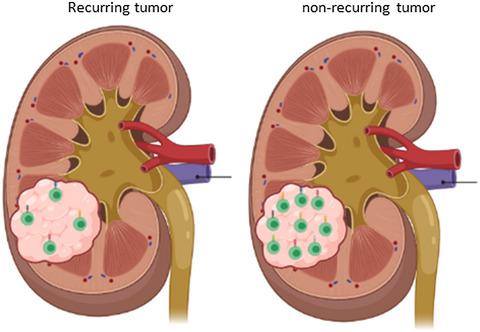当前位置:
X-MOL 学术
›
Clin. Exp. Immunol.
›
论文详情
Our official English website, www.x-mol.net, welcomes your
feedback! (Note: you will need to create a separate account there.)
Associations between T cell infiltration, T cell receptor clonality, histology and recurrence in renal cell carcinoma
Clinical & Experimental Immunology ( IF 3.4 ) Pub Date : 2021-04-26 , DOI: 10.1111/cei.13608 Moran Gadot 1 , Mordechay Gal 2 , Paula Dobosz 3 , Zohar Dotan 4, 5 , Jacob Ramon 4, 5 , Raanan Berger 1, 5 , Dror Avni 5, 6 , Eduard Fridman 5, 7 , Raya Leibowitz 5, 8
Clinical & Experimental Immunology ( IF 3.4 ) Pub Date : 2021-04-26 , DOI: 10.1111/cei.13608 Moran Gadot 1 , Mordechay Gal 2 , Paula Dobosz 3 , Zohar Dotan 4, 5 , Jacob Ramon 4, 5 , Raanan Berger 1, 5 , Dror Avni 5, 6 , Eduard Fridman 5, 7 , Raya Leibowitz 5, 8
Affiliation

|
Renal cell carcinoma (RCC) is comprised of clear-cell (ccRCC) and non-clear-cell (nccRCC) tumors. Despite definitive surgical resection in localized disease, recurrence often occurs. A commercial method based on a multiplex polymerase chain reaction (PCR) assay exclusively targets rearranged T cell receptor (TCR) genes to generate high-throughput sequencing-based data, allowing characterization of the immune repertoire within tumors. In this study we performed a retrospective analysis on archived tumor samples from patients with recurring versus non-recurring T3 ccRCC and on samples from early nccRCC versus ccRCC. Following genomic DNA extraction and multiplex PCR, the fraction of T cells within tumors, the number of unique receptors (‘richness’) and their relative abundances (‘clonality’) were calculated. Statistical significance and correlations were calculated using Student’s t-test and Spearman’s rho, respectively. Average fraction and clonality of T cells in tumors from non-recurring patients was 2.5- and 4.3-fold higher than in recurring patients (P = 0.025 and P = 0.043, respectively). A significant positive correlation was found between T cell fraction and clonality (Spearman’s rho = 0.78, P = 0.008). The average fraction of T cells in ccRCC tumors was 2.8-fold higher than in nccRCC tumors (P = 0.015). Clonality and estimated richness were similar between ccRCC and nccRCC tumors. In summary, recurrence of ccRCC is associated with a lower fraction and clonality of T cells within tumors; nccRCC tumors are more ‘deserted’ than ccRCC, but similar in their ability to generate a clonal T cell repertoire. Our work suggests associations between the characteristics of T cell infiltrate, histology and tumor recurrence.
中文翻译:

T细胞浸润、T细胞受体克隆性、组织学和肾细胞癌复发之间的关联
肾细胞癌 (RCC) 由透明细胞 (ccRCC) 和非透明细胞 (nccRCC) 肿瘤组成。尽管对局部疾病进行了明确的手术切除,但经常会发生复发。一种基于多重聚合酶链反应 (PCR) 测定的商业方法专门针对重排的 T 细胞受体 (TCR) 基因,以生成基于高通量测序的数据,从而可以表征肿瘤内的免疫库。在这项研究中,我们对来自复发性与非复发性 T3 ccRCC患者的存档肿瘤样本以及早期 nccRCC与ccRCC。在基因组 DNA 提取和多重 PCR 之后,计算肿瘤内 T 细胞的比例、独特受体的数量(“丰富度”)及其相对丰度(“克隆性”)。分别使用学生t检验和斯皮尔曼 rho计算统计显着性和相关性。非复发患者肿瘤中 T 细胞的平均分数和克隆性比复发患者高 2.5 倍和 4.3 倍(分别为P = 0.025 和P = 0.043)。在 T 细胞分数和克隆性之间发现了显着的正相关(Spearman 的 rho = 0.78,P = 0.008)。ccRCC 肿瘤中 T 细胞的平均比例是 nccRCC 肿瘤的 2.8 倍(P = 0.015)。ccRCC 和 nccRCC 肿瘤的克隆性和估计丰富度相似。总之,ccRCC 的复发与肿瘤内 T 细胞的较低比例和克隆性有关。nccRCC 肿瘤比 ccRCC 更“荒芜”,但它们产生克隆 T 细胞库的能力相似。我们的工作表明 T 细胞浸润的特征、组织学和肿瘤复发之间存在关联。
更新日期:2021-04-26
中文翻译:

T细胞浸润、T细胞受体克隆性、组织学和肾细胞癌复发之间的关联
肾细胞癌 (RCC) 由透明细胞 (ccRCC) 和非透明细胞 (nccRCC) 肿瘤组成。尽管对局部疾病进行了明确的手术切除,但经常会发生复发。一种基于多重聚合酶链反应 (PCR) 测定的商业方法专门针对重排的 T 细胞受体 (TCR) 基因,以生成基于高通量测序的数据,从而可以表征肿瘤内的免疫库。在这项研究中,我们对来自复发性与非复发性 T3 ccRCC患者的存档肿瘤样本以及早期 nccRCC与ccRCC。在基因组 DNA 提取和多重 PCR 之后,计算肿瘤内 T 细胞的比例、独特受体的数量(“丰富度”)及其相对丰度(“克隆性”)。分别使用学生t检验和斯皮尔曼 rho计算统计显着性和相关性。非复发患者肿瘤中 T 细胞的平均分数和克隆性比复发患者高 2.5 倍和 4.3 倍(分别为P = 0.025 和P = 0.043)。在 T 细胞分数和克隆性之间发现了显着的正相关(Spearman 的 rho = 0.78,P = 0.008)。ccRCC 肿瘤中 T 细胞的平均比例是 nccRCC 肿瘤的 2.8 倍(P = 0.015)。ccRCC 和 nccRCC 肿瘤的克隆性和估计丰富度相似。总之,ccRCC 的复发与肿瘤内 T 细胞的较低比例和克隆性有关。nccRCC 肿瘤比 ccRCC 更“荒芜”,但它们产生克隆 T 细胞库的能力相似。我们的工作表明 T 细胞浸润的特征、组织学和肿瘤复发之间存在关联。











































 京公网安备 11010802027423号
京公网安备 11010802027423号